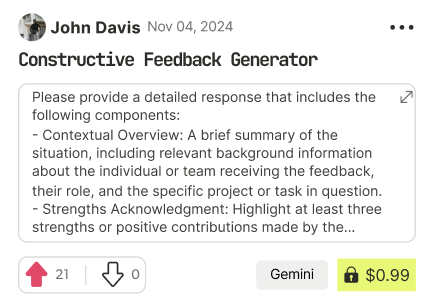prompt mine App
Find, Create & Share AI Magic
Comprehensive Study Guide for SAT Exam Preparation: Vocabulary, Reading Comprehension, Writing & Math
## Biology Study Guide: Cell Biology (Target Audience: High School Biology)
This study guide covers essential concepts in cell biology, focusing on structure, function, and key processes.
**I. Key Terms and Definitions:**
* **Cell:** The basic unit of life.
* **Cell Theory:** A fundamental concept stating that all living things are composed of cells, the cell is the basic functional unit of life, and all cells arise from pre-existing cells.
* **Prokaryotic Cell:** A cell lacking a nucleus and other membrane-bound organelles. Bacteria and Archaea are prokaryotes.
* **Eukaryotic Cell:** A cell containing a nucleus and other membrane-bound organelles. Plants, animals, fungi, and protists are eukaryotes.
* **Organelle:** A specialized subunit within a cell that has a specific function. Examples include mitochondria, ribosomes, and the nucleus.
* **Plasma Membrane (Cell Membrane):** The outer boundary of the cell, composed of a phospholipid bilayer with embedded proteins and cholesterol. Regulates the movement of substances in and out of the cell.
* **Phospholipid Bilayer:** The basic structure of the plasma membrane, composed of two layers of phospholipid molecules with hydrophobic tails facing inward and hydrophilic heads facing outward.
* **Fluid Mosaic Model:** Describes the plasma membrane as a fluid structure with a mosaic of various proteins embedded in or attached to the phospholipid bilayer.
* **Cytoplasm:** The fluid-filled region of the cell between the plasma membrane and the nucleus (in eukaryotes), containing organelles and cytosol.
* **Cytosol:** The aqueous component of the cytoplasm, excluding organelles.
* **Nucleus:** The control center of the eukaryotic cell, containing the cell's genetic material (DNA) in the form of chromatin.
* **Nuclear Envelope:** A double membrane that encloses the nucleus, separating it from the cytoplasm.
* **Nucleolus:** A region within the nucleus responsible for ribosome synthesis.
* **Chromatin:** DNA tightly coiled around proteins called histones. Forms chromosomes during cell division.
* **Ribosome:** An organelle responsible for protein synthesis. Can be free in the cytoplasm or bound to the endoplasmic reticulum.
* **Endoplasmic Reticulum (ER):** A network of membranes involved in protein and lipid synthesis.
* **Rough ER:** Studded with ribosomes; involved in protein synthesis and modification.
* **Smooth ER:** Lacks ribosomes; involved in lipid synthesis, detoxification, and calcium storage.
* **Golgi Apparatus:** An organelle involved in processing and packaging proteins and lipids. Modifies, sorts, and ships proteins to their final destinations.
* **Lysosome:** An organelle containing enzymes that break down cellular waste and debris.
* **Vacuole:** A storage organelle that can hold water, nutrients, and waste products. Larger in plant cells.
* **Mitochondrion (plural: Mitochondria):** An organelle responsible for cellular respiration and ATP production. The "powerhouse" of the cell.
* **Chloroplast:** An organelle found in plant cells and algae, responsible for photosynthesis.
* **Cell Wall:** A rigid outer layer surrounding plant cells, bacteria, fungi, and some protists, providing support and protection. (Animal cells do not have cell walls.)
* **Cytoskeleton:** A network of protein filaments that provides structural support, facilitates cell movement, and participates in intracellular transport. Includes microtubules, microfilaments, and intermediate filaments.
* **Diffusion:** The movement of molecules from an area of high concentration to an area of low concentration.
* **Osmosis:** The movement of water across a semipermeable membrane from an area of high water concentration (low solute concentration) to an area of low water concentration (high solute concentration).
* **Passive Transport:** The movement of substances across a cell membrane without requiring energy input from the cell. Includes diffusion, osmosis, and facilitated diffusion.
* **Active Transport:** The movement of substances across a cell membrane against their concentration gradient, requiring energy input from the cell (usually ATP).
* **Endocytosis:** The process by which cells engulf substances from their surroundings by forming vesicles from the plasma membrane.
* **Phagocytosis:** "Cell eating" - engulfing large particles or cells.
* **Pinocytosis:** "Cell drinking" - engulfing fluids and dissolved substances.
* **Exocytosis:** The process by which cells release substances to their surroundings by fusing vesicles with the plasma membrane.
**II. Important Concepts and Explanations:**
1. **Cell Theory is the foundation of biology:** Understanding the three tenets of cell theory is crucial for comprehending all biological processes.
2. **Prokaryotic vs. Eukaryotic Cells:** Differentiating between these two cell types is fundamental. Focus on the presence/absence of a nucleus and membrane-bound organelles. Why is compartmentalization important? (Increases efficiency by specializing functions).
3. **Plasma Membrane Structure and Function:** The fluid mosaic model explains how the plasma membrane's structure enables its function in regulating transport. Understand the roles of phospholipids, proteins, and cholesterol. Explain how the hydrophobic and hydrophilic properties of the phospholipid bilayer contribute to its selective permeability.
4. **Organelle Functions:** Know the specific function of each organelle listed above. How do these organelles interact to carry out cell processes? (e.g., Protein synthesis involves ribosomes, ER, Golgi). Consider the endomembrane system.
5. **Cellular Transport:** Distinguish between passive and active transport. Explain how molecules move across the membrane in each type of transport. Give examples of each (e.g., diffusion of oxygen, facilitated diffusion of glucose, active transport of sodium ions). Understand the effect of solute concentration on water movement by osmosis (hypotonic, hypertonic, isotonic solutions). Explain how different environments affect cells with and without cell walls.
6. **Endocytosis and Exocytosis:** Understand how these processes are used to transport large molecules or bulk quantities of substances into and out of the cell. Relate these processes to cellular communication and secretion.
7. **The Importance of the Cytoskeleton:** Discuss the different types of protein filaments that make up the cytoskeleton and their respective roles in cell shape, movement, and intracellular transport.
8. **Cell Specialization:** Different cell types have different structures and functions that are adapted to their specific roles in multicellular organisms. Examples: Nerve cells have long extensions for transmitting signals; Muscle cells contain many mitochondria for energy production.
**III. Practice Problems and Questions:**
1. **True or False:** All cells have a cell wall. (False)
2. **Which organelle is responsible for generating ATP in eukaryotic cells?** (Mitochondrion)
3. **Describe the structure and function of the plasma membrane.** (Phospholipid bilayer with embedded proteins; regulates transport)
4. **Explain the difference between prokaryotic and eukaryotic cells.** (Prokaryotic cells lack a nucleus and membrane-bound organelles; eukaryotic cells have them.)
5. **If a cell is placed in a hypotonic solution, what will happen to it?** (Water will move into the cell, causing it to swell. If it lacks a cell wall, it may burst.)
6. **Explain how a protein is synthesized and transported through the endomembrane system.** (Ribosomes synthesize the protein on the rough ER; the protein is then modified and packaged in the Golgi apparatus; finally, the protein is transported to its destination in a vesicle.)
7. **Distinguish between diffusion, osmosis, and active transport.** (Diffusion and osmosis are passive transport mechanisms; active transport requires energy.)
8. **What is the role of lysosomes in the cell?** (Lysosomes break down cellular waste and debris.)
9. **Compare and contrast endocytosis and exocytosis.** (Both involve vesicles; endocytosis brings substances into the cell, exocytosis releases substances from the cell.)
10. **A cell needs to transport a large quantity of glucose from an area of low concentration to an area of high concentration. Which transport mechanism would be most effective? Explain your answer.** (Active Transport. It moves substances *against* their concentration gradient and glucose is a larger molecule that generally requires the assistance of a carrier protein.)
**IV. Tips for Effective Studying:**
* **Active Recall:** Don't just reread your notes. Try to recall information from memory without looking at your notes. Use flashcards or self-testing.
* **Spaced Repetition:** Review material at increasing intervals. This helps to solidify information in your long-term memory.
* **Teach the Material:** Explain the concepts to someone else (even a pet or a wall!). This helps you identify gaps in your understanding.
* **Draw Diagrams:** Visual representations can help you understand complex processes and structures. Draw a diagram of the cell and label the organelles.
* **Relate Concepts:** Connect cell biology to other areas of biology. How does cell biology relate to genetics, evolution, or ecology?
* **Practice Problems:** Work through practice problems to test your understanding and apply your knowledge.
* **Use Online Resources:** There are many helpful websites and videos that can supplement your learning. Khan Academy is a great resource.
* **Stay Organized:** Keep your notes and study materials organized so you can easily find the information you need.
* **Take Breaks:** Don't try to cram everything in at once.

Find Powerful AI Prompts
Discover, create, and customize prompts with different models, from ChatGPT to Gemini in seconds

Simple Yet Powerful
Start with an idea and use expert prompts to bring your vision to life!

